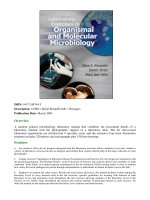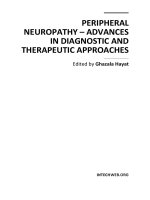RECENT ADVANCES IN HIP AND KNEE ARTHROPLASTY pot
Bạn đang xem bản rút gọn của tài liệu. Xem và tải ngay bản đầy đủ của tài liệu tại đây (33.59 MB, 464 trang )
RECENT ADVANCES IN HIP
AND KNEE ARTHROPLASTY
Edited by Samo K. Fokter
Recent Advances in Hip and Knee Arthroplasty
Edited by Samo K. Fokter
Published by InTech
Janeza Trdine 9, 51000 Rijeka, Croatia
Copyright © 2011 InTech
All chapters are Open Access distributed under the Creative Commons Attribution 3.0
license, which allows users to download, copy and build upon published articles even for
commercial purposes, as long as the author and publisher are properly credited, which
ensures maximum dissemination and a wider impact of our publications. After this work
has been published by InTech, authors have the right to republish it, in whole or part, in
any publication of which they are the author, and to make other personal use of the
work. Any republication, referencing or personal use of the work must explicitly identify
the original source.
As for readers, this license allows users to download, copy and build upon published
chapters even for commercial purposes, as long as the author and publisher are properly
credited, which ensures maximum dissemination and a wider impact of our publications.
Notice
Statements and opinions expressed in the chapters are these of the individual contributors
and not necessarily those of the editors or publisher. No responsibility is accepted for the
accuracy of information contained in the published chapters. The publisher assumes no
responsibility for any damage or injury to persons or property arising out of the use of any
materials, instructions, methods or ideas contained in the book.
Publishing Process Manager Adriana Pecar
Technical Editor Teodora Smiljanic
Cover Designer InTech Design Team
First published January, 2012
Printed in Croatia
A free online edition of this book is available at www.intechopen.com
Additional hard copies can be obtained from
Recent Advances in Hip and Knee Arthroplasty, Edited by Samo K. Fokter
p. cm.
ISBN 978-953-307-841-0
free online editions of InTech
Books and Journals can be found at
www.intechopen.com
Contents
Preface IX
Part 1 Hip Arthroplasty 1
Chapter 1 Degenerative Hip Joint Pain –
The Non-Arthroplasty Surgical Options 3
Ahmed Alghamdi and Martin Lavigne
Chapter 2 Hip Arthroplasty 27
N. A. Sandiford, U. Alao, J. A. Skinner and S. R. Samsani
Chapter 3 Hip Fracture in the Elderly: Partial or Total Arthroplasty? 43
Samo K. Fokter and Nina Fokter
Chapter 4 Why Minimally Invasive Surgery in Hip Arthroplasty? 55
Antonio Silvestre, Fernando Almeida, Pablo Renovell,
Raúl López, Laura Pino and Luis Puertes
Chapter 5 Minimally Invasive Total Hip Arthroplasty 69
Mel S. Lee
Chapter 6 The Effect of Drainage After Hip Arthroplasty 85
Andrej Strahovnik and Samo K. Fokter
Chapter 7 Rehabilitation of Patients Following Arthroplasty
of the Hip and Knee 99
Magdalena Wilk-Frańczuk
Chapter 8 Methods for Optimising Patient Function
After Total Hip Arthroplasty 119
Tosan Okoro, Andrew Lemmey,
Peter Maddison and John G. Andrew
Part 2 Special Topics in Hip Arthroplasty 133
Chapter 9 Planning of Arthroplasty in Dysplastic Hips 135
Nevzat Selim Gokay, Alper Gokce, Bulent Alp and Fahri Erdogan
VI Contents
Chapter 10 Hip Arthroplasty in Highly Dislocated Hips 153
Zoran Bascarevic, Zoran Vukasinovic,
Violeta Bascarevic and Vladimir Bascarevic
Chapter 11 Modular Femoral Neck Fracture
After Total Hip Arthroplasty 169
Igor Vučajnk and Samo K. Fokter
Chapter 12 Surface Replacement of Hip Joint 181
Hiran Amarasekera and Damian Griffin
Chapter 13 Retrograde Stem Removal Techniques in
Revision Hip Surgery 191
Kálmán Tóth
Part 3 Knee Arthroplasty 201
Chapter 14 History of Condylar Total Knee Arthroplasty 203
Luca Amendola, Domenico Tigani, Matteo Fosco and Dante Dallari
Chapter 15 The UniSpacer™:
Correcting Varus Malalignment in Medial Gonarthrosis 223
Joern Bengt Seeger and Michael Clarius
Chapter 16 Posterior Stabilized Total Knee Arthroplasty 231
Fabio Orozco and Alvin Ong
Chapter 17 Mobile Bearing Concept in Knee Arthroplasty 241
Nahum Rosenberg, Arnan Greental and Michael Soudry
Chapter 18 Soft Tissue Balance in Total Knee Arthroplasty 249
Tomoyuki Matsumoto, Hirotsugu Muratsu, Seiji Kubo,
Masahiro Kurosaka and Ryosuke Kuroda
Chapter 19 The Role of Drainage After Total Knee Arthroplasty 267
Ta-Wei Tai, Chyun-Yu Yang and Chih-Wei Chang
Chapter 20 Proximal Tibiofibular Joint
in Knees with Arthroplasty 275
Hakan Boya
Part 4 Special Topics in Knee Arthroplasty 281
Chapter 21 Special Situations in Total Knee Arthroplasty 283
Orlando M. de Cárdenas Centeno and Felix A. Croas Fernández
Chapter 22 Patient-Specific Patellofemoral Arthroplasty 301
Domenick J. Sisto, Ronald P. Grelsamer and Vineet K. Sarin
Contents VII
Chapter 23 Fixation of Periprosthetic Supracondylar Femur Fractures
Above Total Knee Arthroplasty – The Indirect Reduction
Technique with the Condylar Blade Plate and
the Minimally Invasive Technique with the LISS 315
K. Kolb, P.A. Grützner, F. Marx and W. Kolb
Chapter 24 Knee Arthrodesis with the Ilizarov External Fixator as
Treatment for Septic Failure of Knee Arthroplasty 343
M. Spina, G. Gualdrini, M. Fosco and A. Giunti
Part 5 Computer Assisted Total Knee Arthroplasty 355
Chapter 25 Strategies to Improve the Function, Kinematic and
Implants’ Positioning of a TKA with Minimally
Invasive Computer-Assisted Navigation 357
Nicola Biasca and Matthias Bungartz
Chapter 26 Possibilities of Computer Application
in Primary Knee Replacement 381
František Okál, Adel Safi, Martin Komzák and Radek Hart
Chapter 27 Concepts in Computer Assisted
Total Knee Replacement Surgery 397
M. Fosco, R. Ben Ayad, R. Fantasia, D. Dallari and D. Tigani
Chapter 28 Computer Assisted Orthopedic Surgery in TKA 421
Eun Kyoo Song and Jong Keun Seon
Chapter 29 Computer Assisted Total Knee Arthroplasty –
The Learning Curve 443
Jean-Claude Bové
Preface
The purpose of this book is to offer an exhaustive overview of recent insights into the
current state of the art in most performed arthroplasties of large joints in lower
extremities.
The tremendous long term success of Sir Charnley’s total hip arthroplasty has
encouraged many researchers, physicians, surgeons, and technicians to search for
new applications, designs, technology, and surgical exposures to treat pain, improve
function, and create solutions for a higher quality of life. Indeed, the story of success
was repeated very soon with knee arthroplasty. Moreover, the number of knee
arthroplasties has shown almost exponential growth worldwide, and has exceeded
the number of total hip arthroplasties in many clinics in the Western countries
within the past decade.
The treatment options in degenerative joint disease have evolved very quickly. Many
surgical procedures are quite different today than they were only five years ago. In
this book, we endeavor to provide a comprehensive, up-to-date analysis and
description of the treatment of joint disease. Although nonsurgical measures are
mentioned, the emphasis is on hip and knee problems that require surgical treatment.
In an effort to be comprehensive, this book addresses hip arthroplasty with special
emphasis on evolving minimally invasive surgical techniques. Some challenging topics
in hip arthroplasty are additionally covered in a special section. Regarding knee
arthroplasty, particular attention is given to different designs of endoprostheses and soft
tissue balance. Special situations in knee arthroplasty are covered in a special section.
Recent advances in computer technology created the possibility for the routine use of
navigation in knee arthroplasty. This remarkable success is covered in depth as well.
Each chapter includes current philosophies, techniques, and an extensive review of
the literature. We have been as fortunate as to have an outstanding group of
arthroplasty specialists from all over the world contributing to this text. Some
current topics have been discussed by several authors, therefore, repetition is
inevitable. However, as the problems are illuminated from different points of view,
this brings an added value to the book.
X Preface
We especially wish to acknowledge the contributing authors. Without them, a work of
this magnitude would simply not be feasible. We thank them for allocating much of
their very valuable time to this project. Not only do we appreciate their participation,
but also their adherence as a group to the time parameters set for this publication.
Dr. Samo K. Fokter, MD,
Assist. Professor and Chairman,
Dept. for Orthopaedic Surgery and Sports Trauma,
Celje Teaching Hospital
Slovenia
Part 1
Hip Arthroplasty
1
Degenerative Hip Joint Pain –
The Non-Arthroplasty Surgical Options
Ahmed Alghamdi and Martin Lavigne
Université de Montréal
Canada
1. Introduction
Degenerative Hip Joint Pain (DHJP) is a major cause of functional limitation in both young
active and old sedentary patients. Total hip arthroplasty (THA) is one of the most successful
surgical procedures performed in orthopaedics. Sir John Charnley introduced the concept of
low friction arthroplasty for end stage hip arthritis. The rewarding result of this procedure
makes THA the gold standard for the treatment of end stage degenerative hip disease. In a
recent retrospective study to establish the implant survivorship after THA in young patient
at 25 years follow up, up to 89% (80%-98%) survivorship was reported among patients who
were diagnosed with developmental dysplasia, 85% (77%-93%) in patients diagnosed with
rheumatoid arthritis and 74% (61%-87%) in patients group with idiopathic degenerative
arthritis of the hip[1]. Despite improved surgical technique, implant biomaterial and
prosthesis design, complications such as recurrent dislocation, osteolysis and loosening still
exist. Failure of THA may present with particular problems when revision arthroplasty is
needed in young patient, which makes hip joint preservation techniques still actual in this
population (hip arthroscopy, surgical dislocation with osteochondroplasty, periacetabular
osteotomy, proximal femur osteotomy), and put back on track older surgical procedures
such as hip fusion or resection arthroplasty for certain rare indications.
2. Evaluation of painful hip joint
Evaluation of painful hip joint starts with history and physical examination followed by
imaging study and laboratory investigation, as needed. Patient with DHJP presents with
acute or insidious onset pain, usually with a recurring pattern. It is critical to differentiate
sources of hip pain originating from intra-articular pathology from those secondary to extra
articular pathology. Intra-articular pathology usually causes deep-seated pain, localized in
the anterior groin or inguinal region, although pain of intra-articular origin may be felt at
any area around the hip joint. Individuals with symptoms secondary to Femoroacetabular
impingements (FAI) might indicate the location of pain by gripping the lateral hip, just
above the greater trochanter, between the abducted thumb and index finger. This is known
as C-sign[2]. Other symptoms of intra-articular pathology include catching, popping and
locking, although those symptoms may represent a misinterpretation of extra-articular
conditions such as snapping of the psoas tendon or of the tensor fascia lata.
Recent Advances in Hip and Knee Arthroplasty
4
The pain is usually aggravated by weight bearing, going upstairs, and prolonged seating
with hip flexion and adduction as in limited seat space, such as a car seat.
Extra-articular pathology will cause pain mostly in the pubic area, lateral trochanter region,
buttock region, or posterior thigh. Referred pain from spine or vascular claudication should
be ruled out. Pelvic pathology and anterior abdominal wall hernia might cause pain in the
groin region.
Physical examination starts with inspection of the patient gait while getting into the office. A
limp, Trendelenburg lurch and poor trunk balance should be looked for[3]. Inspection may
disclose pelvis malposition, joint contractures or limb inequality. The foot progression angle
should be observed. The patient should sit for history taking. After history, the patient
should lay supine on the examination table. Ligament laxity can be tested. Log roll the limb
to elicit any pain secondary to intra-articular pathology by rotating the femoral head in the
acetabulum. Bony prominences, muscles and tendons around the hip joint, along with, the
sciatic nerve and bursa overlying the greater trochanter are then palpated. Anterior
abdominal wall examination and groin hernia test should be done. The spine, sacroiliac joint
and the knee should also be examined. A complete neurovascular assessment of the limb
involved should then be performed. Ranges of motion should be done both actively and
passively (Table 1).
Range of motion Value
Flexion 110-120
Extension 10-15
Abduction 30-50
Adduction 20-30
External rotation at 90 degree 40-60
Internal rotation at 90 degree 30-40
Table 1. Hip range of motion
Special test:
Anterior labral stress test: while the patient in supine position, takes the patients leg
into flexion, adduction, and slight internal rotation to compress the anterior part of the
labrum. A positive test has occurred if the pain has been reproduced and implies an
anterior superior tear. Other clinical finding to look for would be crepitus, popping,
clicking.
Posterior labral stress test: patient lay in a prone position, and then the examiner will
take the patients leg into passive hyperextension, abduction and external rotation. If
this motion elicits the pain, a positive test has occurred secondary to posterior tear.
Anterior impingement test: Passive combination of flexion, adduction and internal
rotation will cause pain in the anterior groin, which may suggest the presence of FAI.
Posterior impingement test: hyperextension and external rotation will cause posterior
impingement and pain, although pain in this position might be secondary to instability.
Ober’s test: The patient is positioned in lateral decubitus with the affected side up.
The examiner will stabilize the pelvis from the back and hold the leg in neutral
rotation and abduction with the knee in 90 degrees of flexion. The hip is then
extended and slowly adducted down towards the table. The knee will not reach the
examination table because of restricted adduction due to the tight iliotibial band.
Lateral knee pain might occur.
Degenerative Hip Joint Pain – The Non-Arthroplasty Surgical Options
5
Snapping test: Patient can be asked to reproduce the snapping. An audible snap tends
to occur more frequently with internal coxa saltans (psoas snapping on the pubic
eminence), and can be reproduced when the hip is actively extended from a flexed and
abducted hip position. A palpable sapping on the lateral aspect of the hip suggests
external coxa saltans (usually tight of thickened iliotibial band sliding over the greater
trochanter). Patient can reproduce external snapping while performing cycling move in
lateral decubitus. Palpation over the GT may cause tenderness.
The Trendelenburg test should be performed to rule out gluteus medius weakness.
Thomas test: The patient lay supine on the examination table and hold one knee in
direction of his chest, while the other leg remains extended. Positive Thomas test occur
when the patient cannot keep the opposing leg extended secondary to the hip fixed
flexion contraction.
Imaging study: [4]
Anteroposterior (AP) pelvis view: Standard pelvic view can be taken with the patient
supine, or preferably standing. The coccyx should be centered 2-3 cm above the
symphisis pubis. Both obturator foramens should look symmetrical.
Fig. 1. AP pelvic view, centered view; symmetric obturator foramina, centered coccyx with
2-3 cm distance above the pubic symphisis.
Recent Advances in Hip and Knee Arthroplasty
6
Lateral views of the hip:
Frog leg lateral: mostly a view of the proximal femur
Cross table lateral: view the acetabulum and proximal femur
Dunn 45/90: specific view of anterior femoral head-neck junction. This view can be
taken with the hip at 45 or 90 degree of flexion.
False profile: for measuring anterior acetabular coverage
Fig. 2. False-profile view, the anterior centre-edge (VCA) angle quantifies the anterior cover
of the femoral head, and angles of less than 20° are considered abnormal.
AP hip view: the x-ray beam is centered on the hip joint. Not reliable for cross over sign.
Computer Tomography (CT) scans: with 3-D reconstruction, can be more accurate for pre-
operative impingement evaluation or other deformation of acetabulum or femur.
Magnetic resonance imaging (MRI) scan: good diagnostic tool for both soft tissue and bone
strucutre. Intra-articular contrast injection can be use for further evaluation of labrum.
Alpha angle of Notzli was described on a specific MRI view, although it is currently
measured on different radiographic modalities[5].
Ultrasound scan: can provide dynamic evaluation. It can be used as therapeutic tool as
well[6].
Bone scan: usually non specific
Bursography: can be used for snapping hip.
Degenerative Hip Joint Pain – The Non-Arthroplasty Surgical Options
7
3. Hip arthroscopy
The first recorded attempt of arthroscopic visualization of the hip joint is attributed to
Michael Burman in 1930. The limited indications of hip arthroscopy at that time and the
anatomic constraints of the hip joint with suboptimal equipment design have limited the use
of hip arthroscopy for long time. However with improved hip arthroscopy tools, the
indications for hip arthroscopy continue to evolve. Currently, many clinical issues related to
the hip joint and the surrounding tissue can be treated with hip arthroscopy. Degenerative
hip conditions that can be treated with hip arthroscopy are listed in Table 2.
De
g
enerative Indications No
n
-De
g
enerative indications
Labral Lesions
Chondral injuries
FAI
Degenerative arthritis
Loose bodies (traumatic or synovial chondomatosis)
Sepsis
Synovial disease
Instability
Coxa Sultan
(
extern or intern
)
Table 2. Conditions treated with hip arthroscopy
3.1.1 Labral lesions
The etiology of labral tear is traumatic, degenerative, idiopathic or congenital. Labral
pathology can also be classified based on location (anterior, superolateral, posterior).
Anterior labral tears are the most common form in the western population, accounting for
90% of cases. Degenerative labral tears are more and more frequently felt to result from FAI
and usually starts in the avascular (water-shield) white zone of the labral structure. In this
zone, there is low chance of successful healing of the labral tear with conservative treatment.
Labral tears may cause pain and microinstability of the hip joint. They also may increase
friction within the joint and the strain within the articular cartilage; thereby possibly
untreated lesion will result in accelerated degeneration of the joint. In FAI, persisting
conflict between femoral neck and acetabulum will lead to chondral delamination and
thinning, further the labral tear, paralabral cyst and ultimately, degenerative osteoarthritis
Fig. 3. Labral Tear begins at the articular labral junction, termed the watershed region.
Progressive labral degenerations result in paralabral cysts and articular cartilage damage.
Recent Advances in Hip and Knee Arthroplasty
8
of the involved joint. With hip arthroscopy, the labrum can be debrided, resected, repaired
or reconstructed.
3.1.2 Femoroacetabular impingement (FAI)
This is a descriptive diagnosis characterized by combined clinical features and
pathomorphological findings that can result in degenerative changes. The patient’s
pathomorphology is characterized by either cam lesion, pincer lesion or a combination of
both. Mechanical abutment of cam lesion commonly causes pathological changes starting
with focal, deep chondral delamination in the anterolateral (superolateral) region of the
acetabulum. Separation of the labrum-chondral junction will allow the synovial fluid to
extravasate to the subchondral bone or para-labral region creating intra osseous or para-
labral cyst (Figure 3). Leverage of head-cam lesion against the acetabulum with extreme
range of motion can result in contre-coup lesion in posterinferior acetabulum [7]. Leading to
global degenerative changes.
Fig. 4. Cam lesion as seen in skeletonized specimen and frog leg lateral view.
Fig. 5. Pincer Lesion, global over-coverage and labral calcification in 45 years old female.
Notice the relatively minor degenerative changes on the anterior femoral head neck junction.
Degenerative Hip Joint Pain – The Non-Arthroplasty Surgical Options
9
The pincer lesion will cause a crush-type injury of the labrum and progressive degenerative
changes with minimal damage to the articular cartilage of the acetabulum.
Indication of hip arthroscopy in this setting is symptomatic FAI with concomitant labral and
or cartilage lesion. The labrum is addressed as mentioned in the previous section, while the
cartilage damage is addressed by debridement or micro fracture of the underlying
subchondral bone. The osseous abnormalities are treated with an osteochondroplasty and
acetabuloplasty as needed.
3.1.3 Degenerative arthritis
Arthroscopic intervention in early hip joint degeneration may relieve pain and others
associated symptoms (i.e. catching, locking and range of motion limitation). However, as
seen with knee arthroscopy, it provides little benefit on the long term and thus represents a
limited indication for hip arthroscopy. Hip arthroscopy in this clinical scenario will provide
limited role through removal of loose bodies, debridement of degenerative chondral or
labral tears and subtotal synovectomy. Capsular release and osteophyte excision might
improve the hip range of motion.
Before attempting hip arthroscopy for advance degenerative changes, patient needs to know
the limitation of such procedure. The patient are less likely to benefit from hip arthroscopy
when joint space is less than 50% of normal, with pain at rest, functionally depleting
limitation of hip range of motion or pre-operative Harris Hip Score (HHS) of less than 60.
3.2 Surgical technique
Under general, spinal or combined anesthesia, the patient is positioned supine or in
lateral decubitus according to the surgeon’s preference. This section will only address the
hip arthroscopy while the patient on supine position. A well-padded perineal post will be
used to protect the pubis and provide counter traction force during distraction of the hip
joint. The foot should also be well-padded befor connecting the foot attachments.
Distraction of the hip joint is gently performed with the hip slightly flexed in neutral
abduction and rotation until approximately 8 mm of joint space is achieved. Multiple
portals can be used to visualize both central (articular surfaces) and peripheral (extra
articular) compartments of the hip joint. Common portals used are anterior, anterolateral
and posterolateral in relation to the Greater Trochanter (GT). Fluoroscopic views should
be used during portal preparation to ensure enough joint distraction and to avoid labral
penetration. The 70-degree lens is used most of the time. Labral tear, cartilage damage or
over coverage can be treated as described above. Inspection of the peripheral
compartment and excision of the cam lesion can be done without traction with the use of
fluoroscopy x-ray to guide precise cam lesion excision. Dynamic assessment is helpful to
assess the relief of FAI.
3.3 Postoperative rehabilitation
After arthroscopic osteochondroplasty and labral debridement, full weight bearing will be
permitted, unless micro fractures were performed, in which case toe touch weight bearing is
recommended for 6-8 weeks. Aggressive active-passive range of motion and proprioception
exercise will be started early post operative. High impact sport is not allowed for 2 months
post femoral neck osteoplasty.
Recent Advances in Hip and Knee Arthroplasty
10
3.4 Complications
Complications occur in 0.5% to 5% of patients and are most often related to the required
distraction of the hip joint [8]. Sciatic, femoral or pudendal nerve palsy can result from
prolonged traction time. Nerve injury tends to be transient neuropraxia, which completely
resolve spontaneously in few weeks. A well-padded post should prevent perineal tear and
pudendal nerve injury. Bleeding and lateral femoral cutaneous nerve injury can occur
during portal placement. Postoperative persistent secondary to trochanteric bursitis, intra-
articular capsular adhesion (especially between the capsule and repaired labrum, or
between the capsule and anterior neck) may occur. Femoral neck fracture, avascular necrosis
of the femoral head, and under or over resections of cam lesion can be a mode of failure.
Instrumental breakage rarely happen, but sometimes requires open arthrotomy to remove
the broken fragment. Incidence of deep venous thrombosis ranges from 0 to 3.7% in various
retrospective clinical reports[9].
3.5 Results of arthroscopic FAI surgery
Hip arthroscopy for the treatment of FAI has only been used recently. Philippon et al
studied 45 professional athletes at 1.6 years (6 months to 5.5 years) follow up. 93% of
patients returned to professional competition, but only 78% remained active in professional
sport at final follow up[10].
Sampson et al analyzed the results of 183 patients (194 hips) with positive impingement sign
at preoperative assessment at maximum follow up of 29 months. 95% of the patients showed
no sign of impingement at one year after surgery[11].
Byrd et al found an improvement of Harris Hip Score (HHS) from baseline of 20 points
(range 17 to 60 point), which was reported in 83% of patients at 1 year follow up[12].
Another study reported by Philippon et al analyzed 112 patients at mean follow up of 2.3
years. The HHS improved from 58 to 84.3 in those patients with FAI associated with labral
and chondral pathology. However, 8.9% of the patient underwent THA at mean follow up
of 16 months[13].
4. Combined limited open arthrotomy and hip arthroscopy
Combined limited open arthrotomy and hip arthroscopy can be utilized to treat
symptomatic anterolateral FAI: the hip arthroscopy will focus on any labral pathology and
allow microfracturing for acetabular chondral damage. The limited arthrotomy approach
will allow easy access to the pathologic part of the femoral head neck junction.
4.1 Surgical technique
Patient is positioned supine, exactly the same as described in previous section. After
arthroscopic treatment of labral and chondral lesions, the traction is released. Anterior or
anterolateral approach can be performed. We prefer a modified Watson-Jones approach,
which allow better visualization of the anterolateral and posterolateral aspect of head neck
junction. The 8-10 cm incision starts 2-3 cm distal and 2-3 cm lateral to the Anterior Superior
Iliac Spine (ASIS) directed distally and laterally toward the anterior tip of GT. Subcutaneous
dissection is carried down to the fascia lata. The interval between Tensor Fascia Lata (TFL)
and Gluteus Medius (GM) muscles can be identified just anterior to the GT after incising the
fascia. The GM is retracted posteriorly while the TFL is retracted anteromedialy. The rectus
femoris tendon is identified and the hip joint capsule exposed. A T-shaped capsulotomy is
Degenerative Hip Joint Pain – The Non-Arthroplasty Surgical Options
11
performed with care to prevent injury of the labrum. Spiked tip retractors can be placed
intracapsular anterior and posterior around the rim of the acetabulum which will allow safe
dynamic assessment of the hip joint. We use a high-speed burr to resect the cam lesion on
the anterolateral femoral neck then ensure effective resection by using intraoperative
fluoroscopy and dynamic assessment of the hip joint. Removing all bone debris and
minimizing muscle damage can play significant role in reducing the incidence of
Heterotopic Ossification (HO). Capsular and fascia lata closure are performed at the end of
the procedure.
4.2 Postoperative care
Weight bearing as tolerated is permitted early post operatively. Contact sport is not allowed
for at least 2-3 months. Active and passive range of motion along with unrestricted
strengthening is allowed. However, when rectus femoris tendon is violated, then restrictions
will be applied on active straight leg raise (SLR) for 6 weeks. Subcutaneous low molecular
weight heparin is given for 10 days.
4.3 Complications
1. Deep venous thromboses and thromboembolic disease.
2. Neurovascular injury.
3. Infection.
4. Femoral neck fracture.
5. HO.
6. Femoral head avascular necrosis (AVN)
7. Complications related to hip arthroscopy procedure.
4.4 Results
Lincoln et al reported a significant difference between the mean Harris hip score
preoperatively and that at last follow-up (from 63.8 to 76.1) of 16 hips treated using
a modified Heuter anterior approach combined with adjunctive hip arthroscopy.
Clohisy et al reported the results of combined arthroscopy and limited open
osteochondroplasty for anterior FAI in 35 patients. HHS improved from 63.8 to 87.4 at
minimum follow up of 2 years. No fracture of the femoral neck or AVN of the femoral head
was reported[14].
Pierannunzii et al found that the mean HHS improved from 74.4 to 85.3 in 8 patients at
mean follow up of 10 months[15].
5. Surgical dislocation of the hip joint
5.1 Indications
Surgical dislocation of the hip joint for the treatment of FAI is safe when performed with
appropriate understanding of the vascular anatomy of the proximal femur. Surgical
dislocation of the hip is considered the gold standard procedure for the treatment of FAI,
despite the advance of hip arthroscopy technique and the encouraging results of the limited
open surgical procedure. Surgical dislocation of the hip is especially indicated with global or
posterior impingement requiring acetabular rim trimming, with severe deformity of the
Recent Advances in Hip and Knee Arthroplasty
12
proximal femur or when chondral lesions of the femoral head have to be addressed. Patient
with no more than mild arthrosis (Tonnis <=2) and age less than 50 years are considered the
best candidates for such surgical intervention.
5.2 Contraindications
Advance arthrosis, is a contraindication for this procedure.
5.3 Surgical technique
The patient positioned in lateral decubitus under general or combined general and spinal
anesthesia. The pelvis should be stabilized in proper orientation to allow proper evaluation
of the acetabular version.
The incision is curvilinear, approximately 20-25 cm in length and centered over the GT
curving slightly posteriorly at 20 degree angle. The fascia lata is incised and the interval
between TFL and Gluteus Maximus (GMax) is developed to avoid violation of the GMax
muscle fibers. The peritrochantric bursa is incised and retracted anteriorly. The greater
trochanter, short external rotators, gluteus medius and vastus lateralis should be clearly
visualized. The leg is positioned in 20-30 degrees of internal rotation and an oscillating saw
is used to create a trigastrics sliding trochanteric osteotomy of 1-1.5cm thicknesses. Next the
leg is repositioned in neutral rotation and the gluteus minimus is dissected off the hip
capsule from posterior to anterior to allow full mobilization of the trochanteric fragment
anteriorly for performing a safe Z-shape capsulotomy, the capsular incision starts at the
anterior boarder of the GT and is directed proximally in line with the femoral neck with care
Fig. 6. 360 view provide inspection of the acetabulum, one retractor is impacted above the
acetabulum. One retractor hooked on the anterior acetabular rim and a third retractor levers
the neck against the incisura acetabuli.
Degenerative Hip Joint Pain – The Non-Arthroplasty Surgical Options
13
not to injure the labrum. The proximal arm of the capsulotomy runs parallel to the
acetabulum posteriorly toward the piriformis tendon, the closest the capsulotomy to the
acetabular edge the less likely to risk injuring the lateral epiphyseal branches. The distal arm
of the Z-shaped capsulotomy should not extend beyond the lesser trochanter. Distraction
force with the use of bone hook with the hip in flexion and external rotation can help
dislocating the femoral head. The ligamentum teres can prevent complete dislocation and a
curved blunt tip long scissor should be used to cut the ligament if circumferential exposure
of the femoral head is required. A straight spiked Hohmann retractor is placed anteriorly
around the acetabular rim and a curved Hohmann is placed inferiorly under the transverse
ligament to push the femoral head posteriorly. The leg is placed in a sterile bag anteriorly
across the table. This will provide 360-degree acetabular exposure for cartilage defects
treatment, acetabular rim trimming and labral re-fixation (Figure 6). To treat pathology on
the femoral side, the retractors are removed and the head and neck are delivered back into
the surgical wound for evaluation and treatment of any head cartilage defect and head-neck
junction pathology (Figure 7).
When satisfactory treatment is completed, the femoral head is reduced and the capsule is
closed with loose interrupted suture to prevent stretch of retinacular vessels. The greater
trochanter fragment should be reduced and fixed with three 3.5mm screws. The fascia lata
and overlying skin are closed in layers (Figure 8).
Fig. 7. The hip is flexed, externally rotated and distracted to dislocation of the femoral head.
The cam lesion inspected and femoral neck osteoplasty is performed.
5.4 Postoperative care
Patient will be on DVT prophylaxis for 35 days and HO prophylaxis for 2 weeks (Celebrx
200mg twice a day). The patient will be allowed toe touch weight bearing for 6 weeks.
Passive range of motion is allowed in all directions, however active abduction and deep
flexion beyond 90 degree are not allowed for at least 6 weeks.
5.5 Complications
Complications of the surgical dislocation approach for patients who had had the procedure
for multiple differential diagnoses (including Femoroacetabular impingement, Legg-Calve-
Perthes disease in a skeletally mature hip, trauma, and deformity following a slipped capital









